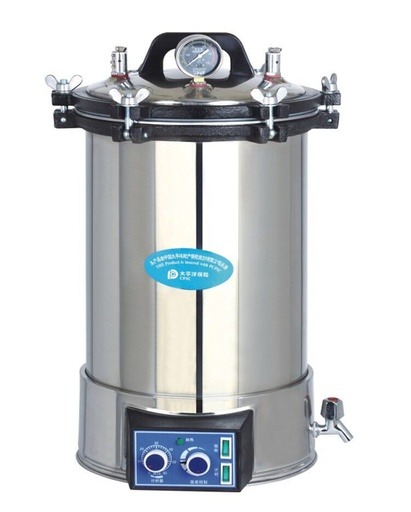Sterilization is an essential process in healthcare, laboratories, and numerous industries. Whether you’re in a hospital, a remote clinic, or a research lab, ensuring sterile equipment is critical. This blog dives into the world of portable autoclaves, exploring their functionality, benefits, and why they are indispensable in many settings.
What is a Portable Autoclave?
A portable autoclave is a compact, mobile sterilization device designed to sanitize medical tools, laboratory equipment, and other items. Unlike traditional, fixed autoclaves, these units are smaller and lightweight, making them perfect for remote or small-scale operations.
Did You Know? According to the Journal of Applied Microbiology, sterilization using autoclaves can reduce microbial load by up to 99.99%, ensuring the highest standards of hygiene.
Comparison Table: Portable vs. Standard Autoclaves
| Feature | Portable Autoclave | Standard Autoclave |
|---|---|---|
| Size and Weight | Compact and Lightweight | Large and Stationary |
| Capacity | Limited | Large |
| Energy Requirement | Low | High |
| Use Case | Mobile or Small Scale | Hospitals, Industries |
Primary Uses of Portable Autoclaves
Portable autoclaves are versatile tools with a wide range of applications:
- Healthcare: Sterilizing surgical tools in clinics and field hospitals.
- Laboratories: Ensuring sterile conditions for experiments.
- Veterinary Practices: Cleaning instruments in rural or mobile setups.
- Tattoo and Beauty Parlors: Maintaining hygiene standards.
Real-Life Example:
A 2022 study published in BMJ Global Health highlighted that portable autoclaves played a critical role in providing sterilization during medical missions in remote areas, enabling over 15,000 surgeries to be performed safely.
Advantages of Using Portable Autoclaves
Why opt for portable autoclaves? Here are some standout benefits:
- Mobility and Convenience
Portable autoclaves can be transported easily, making them ideal for fieldwork. - Cost-Effectiveness
Their smaller size often translates to lower costs—perfect for small businesses or startups. - Energy Efficiency
These units typically consume less power, reducing operating expenses. - Versatility
From sterilizing medical tools to lab glassware, their adaptability is unmatched.
Limitations and Challenges
Despite their advantages, portable autoclaves have certain drawbacks:
- Capacity Constraints: Limited size means fewer tools can be sterilized per cycle.
- Regular Maintenance: Smaller systems often require more frequent checks.
Pro Tip: Always follow the manufacturer’s guidelines to avoid common issues like improper sealing or incomplete sterilization.
Operating and Maintaining a Portable Autoclave
Proper operation ensures safety and efficiency. Here’s a quick guide:
- Load Items Correctly: Avoid overpacking to ensure even steam distribution.
- Set Appropriate Time and Temperature: Typically 121°C for 15-30 minutes.
- Regular Cleaning: Descale the unit every few months to remove mineral buildup.
Common Mistake: Forgetting to check the water level before starting the cycle can cause equipment damage.
Safety Precautions
Safety is non-negotiable when dealing with high-pressure devices. Follow these tips:
- Always wear heat-resistant gloves when handling an autoclave.
- Use distilled water to avoid mineral deposits.
- Regularly inspect safety valves and seals for wear and tear.
Fact Check: Faulty autoclaves cause approximately 20 workplace injuries annually in the U.S. (OSHA data).
How to Choose the Right Portable Autoclave
When shopping for a portable autoclave, consider:
- Capacity: Match the size to your workload.
- Power Source: Look for models with backup power options for field use.
- Durability: Stainless steel chambers offer longevity.
- Certifications: Ensure the unit meets ISO and CE standards for safety.
Have questions? We offer free consultation.
Ensuring Effective Sterilization
The sterilization process must be flawless to prevent contamination.
- Use biological indicators like Bacillus spores to test effectiveness.
- Monitor pressure gauges and temperature displays throughout the cycle.
Interesting Fact: Portable autoclaves typically achieve sterilization in under 30 minutes, compared to 1 hour for larger, bulkier systems.
Applications Across Industries
From healthcare to tattoo studios, portable autoclaves are indispensable:
- Healthcare: Sterilizing scalpels, syringes, and other tools.
- Biotech Labs: Prepping petri dishes and pipettes.
- Food Industry: Ensuring sterilized jars for canning and preserving.
- Beauty Salons: Maintaining hygienic equipment for client safety.
Conclusion
Portable autoclaves are small but mighty tools that cater to diverse sterilization needs. Whether you're a medical professional in a rural clinic or a tattoo artist in a bustling city, these devices ensure safety, hygiene, and efficiency.
By investing in a high-quality portable autoclave and maintaining it properly, you can enjoy reliable sterilization, protect users from contamination, and enhance overall operational standards.
Key Takeaway: Portable autoclaves are not just equipment; they’re lifelines for hygiene-critical tasks in today’s fast-paced world.
→Click here to learn more about our Sterilization Equipment
or

